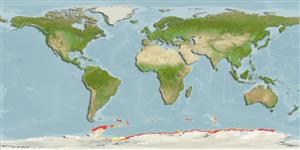Bivalvia |
Arcida |
Philobryidae
Environment: milieu / climate zone / depth range / distribution range
Ecology
Benthic; depth range 0 - 1890 m (Ref. 124196). Polar; 53°S - 79°S, 180°W - 180°E
Southwest Atlantic and the Antarctic.
Length at first maturity / Size / Weight / Age
Maturity: Lm ?, range 1 - ? cm Max length : 0.6 cm TL male/unsexed; (Ref. 7875); common length : 0.3 cm TL male/unsexed; (Ref. 7875)
Life cycle: Fertilization occurs in the mantle cavity after the release of mature eggs in the early austral summer or late spring. Females dominate males in number during summer which is when females are brooding (early stage) nonshelled embryos in the infrabranchial chamber. Shell development begins during late summer and early autumn with simultaneous development of ova, i.e., females may simultaneously carry eggs and brood larvae. Males dominate females in number during late autumn and early winter, it is also when the ova are fully developed. Shelled juveniles are released in late winter to early summer. Egg and embryo development takes 2 years (Refs. 833, 72610, 105049).
SAUP Database 2006 SAUP Database. www.seaaroundus.org. (Ref. 356)
IUCN Red List Status
(Ref. 130435: Version 2025-1)
CITES status (Ref. 108899)
Not Evaluated
Not Evaluated
Threat to humans
Harmless
Human uses
| FishSource |
Tools
More information
Trophic EcologyFood items (preys)
Diet composition
Food consumption
Predators
Population dynamicsGrowthMax. ages / sizesLength-weight rel.Length-length rel.Length-frequenciesMass conversionAbundance PhysiologyOxygen consumption
Human RelatedStamps, coins, misc.
Internet sources
Estimates based on models
Preferred temperature
(Ref.
115969): -1.5 - 1.4, mean -0.5 (based on 473 cells).
Resilience
Low, minimum population doubling time 4.5 - 14 years (K=0.09-0.11).
Fishing Vulnerability
Moderate to high vulnerability (49 of 100).
Price category
Unknown.
